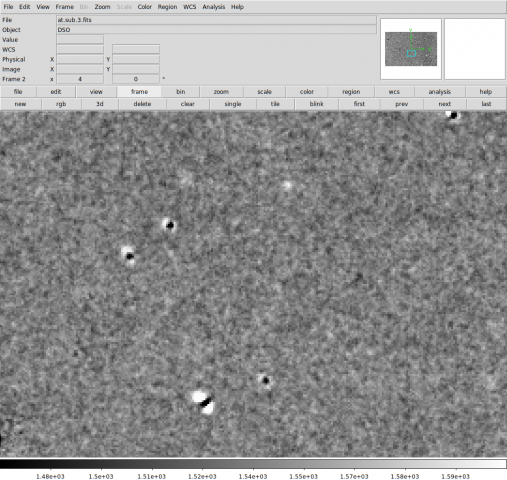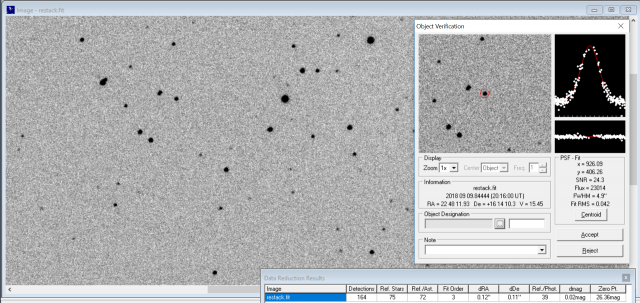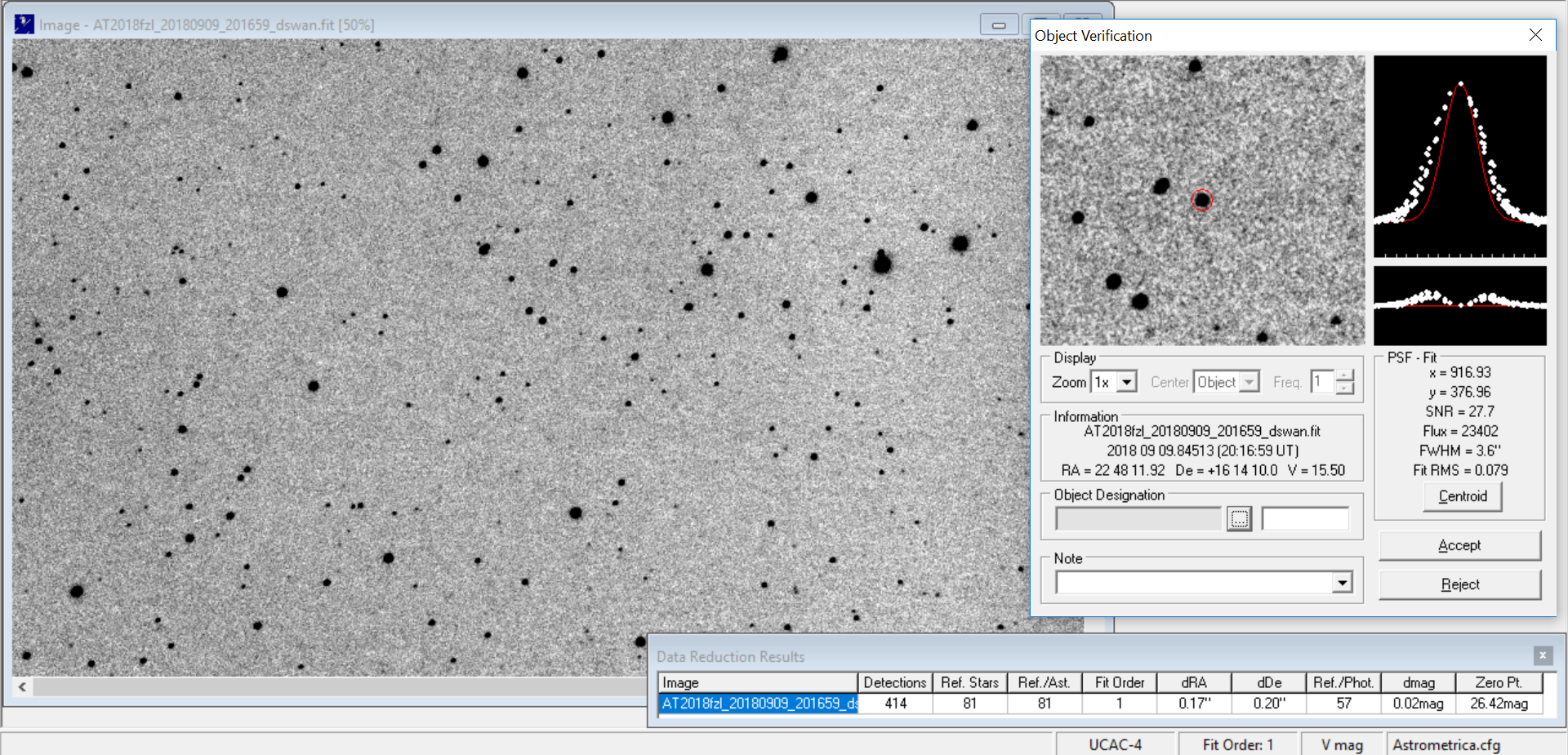› Forums › Variable Stars › Transient location
- This topic has 11 replies, 4 voices, and was last updated 7 years, 3 months ago by
 David Swan.
David Swan.
-
AuthorPosts
-
9 September 2018 at 10:35 pm #574124
 David SwanParticipant
David SwanParticipantHello,
I took some images of transient AT 2018fzl. It is real – there is nothing at all visible on the corresponding DSS image.
My plate solution gives a position of the transient that is a full 1 arcsec in Dec away from the position reported on the Transient Name Server. The plate solution is otherwise excellent in terms of star matching.
Any ideas?
David
The FITS:
https://1drv.ms/u/s!Agvxu8wNOxpAfRoq0IUC9GK4664
Attachments:
10 September 2018 at 8:08 am #579980 Dr Paul LeylandParticipant
Dr Paul LeylandParticipantCould it be a blend?
The residuals plot after the (presumably) Gaussian profile has been subtracted appears asymmetrical to me, with the left hump being somewhat larger than the right.
https://arxiv.org/abs/1809.00018 came to my attention a few days ago which is what made me think of this possible explanation.
Paul
10 September 2018 at 10:23 am #579981 Robin LeadbeaterParticipant
Robin LeadbeaterParticipantA potential target for a spectrum. mag 15 is just about bright enough for a standard ALPY 600 and a modest (say> 10 inch) aperture.
Robin
10 September 2018 at 1:55 pm #579982 David SwanParticipant
David SwanParticipantHi Paul,
The abstract is most interesting – thanks for pointing this out. I’ll read the article proper this eve. I hope Robin or someone else takes up the spectro.
David
10 September 2018 at 7:44 pm #579983 Dr Paul LeylandParticipant
Dr Paul LeylandParticipantNot entirely sure what to make of this …
I took your FITS image and fed it through IRAF’s DAOPHOT pipeline because I knew that it could compute PSFs and subtract them from images. The image below shows an 8x enlarged view of the region of the transient after computed stars had been removed. With the exception of saturated stars and a scattering of doubles, all the bright stars were invisible, meaning that they had been successfully modeled and removed from the image. A good number of faint stars (one is very obvious in the snapshot) had not been removed because they were too faint for accurate photometry with the parameters I chose.
The double next to the transient is very clearly marked as such: the PSF of a single star has been removed from the mid-point. The transient has been removed nicely but two wings remain. I’d say that was fairly conclusive reason for your astrometric result but for the fact that the other two bright stars also show wings.
As I said, I’m not sure what to make of this but post it for your interpretation which may well be better than mine.

BTW, the image below is inverted N/S with respect to your because IRAF counts pixels from the bottom up. Causes no end of confusion …
Paul
10 September 2018 at 8:53 pm #579985 Andy WilsonKeymaster
Andy WilsonKeymasterHi Paul,
I was interested to see you post a link to this paper as I have spent the past couple of years working in the same office as Tom Wilson, with Tim supervising both of us.
I can’t claim to be an expert in his research but it is eye opening to discover how faint contaminant stars can affect astrometry.
Best wishes,
Andy10 September 2018 at 9:03 pm #579984 David SwanParticipant
David SwanParticipantThanks for the image analysis. So with several ‘winged’ bright stars nearby, it looks like PSF contamination is an unlikely explanation. Maybe an artifact produced by the optics or by something weird associated with frame stacking? Hopefully someone else will image this transient at a good scale and post astrometry.
12 September 2018 at 9:06 am #579989 Dr Paul LeylandParticipant
Dr Paul LeylandParticipant“something weird associated with frame stacking”. Ah, I wonder if perhaps some frames have become rotated with respect to the others? If your stacking performs only rectilinear shifts then those near the center of rotation will be stacked perfectly but those further away will be smeared into short arcs. Removing a circularly symmetric synthetic star from the center of an arc will result in wings.
Could you try stacking, say, half the images and see if the result changes? Repeat with a differently chosen half, and again.
12 September 2018 at 9:52 am #579990 David SwanParticipant
David SwanParticipantYes. Thanks Paul.
The raw FITS files are archived on my external drive, so I can go back and do this. It would be nice to identify the source of the problem, as I may need to modify my workflow.
D
12 September 2018 at 8:32 pm #579991 David SwanParticipant
David SwanParticipant
I have re-stacked with more stringent quality criteria (FWHM and roundness). The noise is higher, but the stars look more round. Problem sorted I think! I’ve looked back at my determinations of transient locations, and the difference from the survey telescope position in this case isn’t unusual. Experimenting with the fit order doesn’t really change the measured position either.
13 September 2018 at 4:49 pm #579993 Dr Paul LeylandParticipant
Dr Paul LeylandParticipant“Problem sorted I think!”
Excellent, I’m happy to have been of help.
13 September 2018 at 8:19 pm #579994 David SwanParticipant
David SwanParticipantAppreciated. David
-
AuthorPosts
- You must be logged in to reply to this topic.

